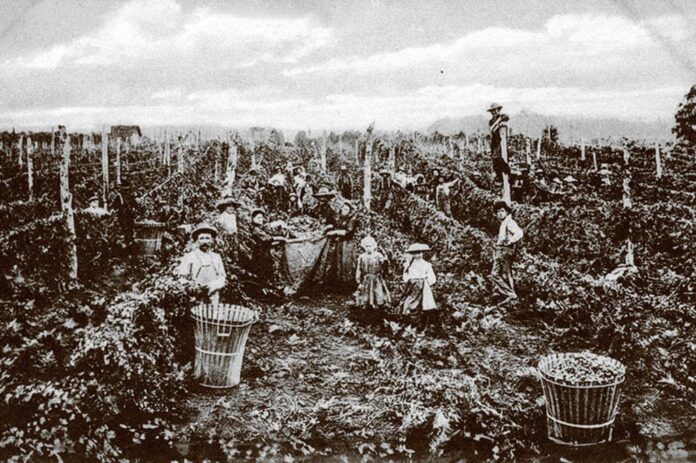Did you know that Oregon has been at the center of hops production almost as long as it’s been a state?
The crop was first introduced in the 1850s, and by the late 1860s, it was being grown commercially. In the early twentieth century, there were 1,500 hops growers in the Willamette Valley, and Oregon produced more hops than any other state in the country!
In 1852, seven years before Oregon was a state, a German immigrant named Henry Saxer opened the Liberty Brewery in Portland. He was followed in 1856 by Henry Weinhard, whose name is well known to all of us.
However, when Oregonians voted to ban alcohol in 1914 (five years before the 14th amendment established national prohibition), alcohol consumption dropped, and breweries closed.
Oregon hop production grew after World War I due to the war’s disastrous effects on European agriculture. From 1922 to 1943, Oregon regained the honor as the nation’s largest producer. By the 1930s, following the repeal of Prohibition, the state’s hop growers expanded production to include over 20,000 acres of hops for a number of years.
Early hops production in Oregon occurred on small family farms with typically less than 20 acres dedicated to the crop. In early day Tigard, the first business aside from farming was raising hops. In a photo of the John Tigard House taken in the nineteen teens, apple trees are seen on one side of the house and trellises for growing hops are on the other. These trellises would be 18 feet tall with wires across the top, and coarse hop twine strung from ground level to the top of the trellis for the vines to grow on.
In “An Illustrated History of the State of Oregon,” published in 1893, it states, “Charles F. Tigard owns a portion of (his father’s) donation land claim, on which he is raising hops; in addition, he has a general merchandise store on the property and is doing a thriving business.”
Nellie Elwert, a well-known teacher of Business Education at Tigard High School for many years, also had a hop farm with her husband outside of Sherwood for 35 years. They sold their hops to Blitz-Weinhard. In a 1977 article in the Tigard Times, she related that pickers were paid 2 cents a pound. They would start picking about 4 a.m. and picked until about 5 p.m. The most they would make per day was about $1.80.
When the hops were ready to be harvested, whole families would come and camp at the hops farm while they all picked hops and earned some additional income. Ella Brandt Bauer, whose daughter LaVerne Sharp was responsible for saving the John Tigard House, told of picking hops as a girl. The Brandt home was next door to the John Tigard House when it was still located on Pacific Highway.
In its collection, the Tigard Historical Association has a hops basket, similar to the ones shown in the photo above, which was donated by Curtis Tigard.
Join the Tigard Historical Association Today!
Benefits of Membership:
Early notice of educational programs, special events and exhibitions.
- Newsletters keeping you informed of local history activities.
- Annual recognition of members in the THA Newsletter.
- Pride in supporting local heritage preservation.
- Opportunity to meet, socialize and volunteer with others who care about local history.
For more information, visit tigardhistorical.org.






















